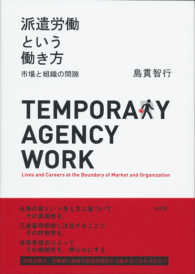Full Description
This quick-reference, highly practical guide is designed to help teachers successfully include students with a disability in the classroom, as well as being a research text.
Armstrong and Roy focus on key 'sticky' issues often referenced by teachers, schools, and government as preventing inclusion, filling in the gaps in current teacher capabilities in responding to these issues. They cover, for example, how to record educational progress for a student with a disability on an Individual Education Plan (IEP), how teachers should respond to occupational violence in a classroom by a student with a disability, and the need to teach routines. The authors provide learning activities and use vignettes throughout the book to offer a story format and help the reader understand how to overcome persistent challenges to educational inclusion for those with a disability. The guidance provided is mapped to relevant Australian teacher standards and government recommendations, and has been successfully road-tested with Australian state governments, schools, and thousands of pre-service teachers.
An essential read for pre-service teachers, this book will also be of interest to new and in-service teachers in the mainstream sector as well as in the special education and alternative school sectors.
Contents
Part I. Educational inclusion: The why. 1. Attendance and the unfolding crisis in education. 2. Objections to this book and myths about inclusion. 3. Understanding inclusion. Part II. Educational inclusion: What and how. 4. Disability: Becoming a developmentally informed teacher. 5. Differentiation and Universal Design for Learning (UDL). 6. Feedback and effective praise. 7. Establishing routines in the classroom. 8. Building strong parent-school partnerships. 9. Behaviour: Building and maintaining calm and productive classrooms. 10. Mental health and well-being in schools. 11. Inclusive assessment 12. Safety in school and bullying prevention. Part III. Final words. 13. Key learnings.








